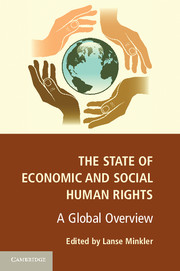Book contents
- Frontmatter
- Contents
- Contributors
- Acknowledgments
- 1 Introduction: Why Economic and Social Human Rights?
- I CORE RIGHTS
- 2 The Right to Food: A Global Perspective
- 3 Globalization and the Right to Health
- 4 Demolishing Housing Rights in the Name of Market Fundamentalism: The Dynamics of Displacement in the United States, India, and South Africa
- 5 Implementation of the Human Right to Social Security around the World: A Preliminary Analysis of National Social Protections Laws
- 6 Why Is the Right to Work So Hard to Secure?
- II NONDISCRIMINATION
- III META
- Index
- References
4 - Demolishing Housing Rights in the Name of Market Fundamentalism: The Dynamics of Displacement in the United States, India, and South Africa
Published online by Cambridge University Press: 05 February 2013
- Frontmatter
- Contents
- Contributors
- Acknowledgments
- 1 Introduction: Why Economic and Social Human Rights?
- I CORE RIGHTS
- 2 The Right to Food: A Global Perspective
- 3 Globalization and the Right to Health
- 4 Demolishing Housing Rights in the Name of Market Fundamentalism: The Dynamics of Displacement in the United States, India, and South Africa
- 5 Implementation of the Human Right to Social Security around the World: A Preliminary Analysis of National Social Protections Laws
- 6 Why Is the Right to Work So Hard to Secure?
- II NONDISCRIMINATION
- III META
- Index
- References
Summary
Introduction
The right to housing is recognized as a fundamental human right within the international human rights system, initially adopted in 1948 by the United Nations General Assembly in Article 25 of the Universal Declaration on Human Rights as an essential aspect of an adequate standard of living, and reaffirmed in Article 11 of the International Covenant on Economic, Social and Cultural Rights in 1976. However, as is the case with most rights, housing rights violations occur throughout the world. These violations include, inter alia, homelessness, forced eviction, demolition of shacks, lack of adequate low-income housing supply, and so forth (UN-HABITAT 2009). An evolving jurisprudence intended to address these violations has developed in a number of countries (UN-HABITAT 2002). Although the right to housing is no different from a jurisprudential perspective than other human rights – insofar as, to fully realize a right to housing, there must be universal access that is adequate and afforded to all without discrimination – on a practical level, housing poses a particular set of challenges to which human rights law and policy work are currently limited in their ability to respond.
Housing situations may differ across regions, countries, provinces, states, cities and towns, but most places have at least two things in common. First, the poor encounter both the greatest barriers to accessing adequate housing, as well as the greatest tenure insecurity and instability (i.e., the most forced displacement) (Advisory Group on Forced Evictions [AGFE] 2007). Second, unlike in education and health care, for example, there are few if any publicly designed or regulated comprehensive national systems for housing that ensure decent access and stability for all. Formal, lawfully occupied housing is primarily market based, with some supplementary government housing for poor and eligible members of society. As a result, housing is often an object of investment as much as a home or a part of a community. Although informal settlements exist, there is generally little if any legal protection extended by the state to “unlawful” occupiers; even within the formal market, security of tenure varies based on an occupant's status as an “owner” or “renter.”
- Type
- Chapter
- Information
- The State of Economic and Social Human RightsA Global Overview, pp. 86 - 116Publisher: Cambridge University PressPrint publication year: 2013
References
- 4
- Cited by

